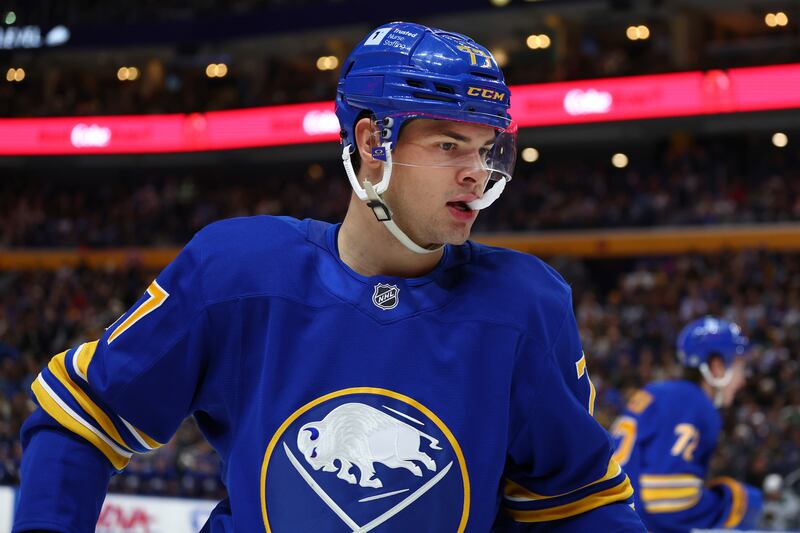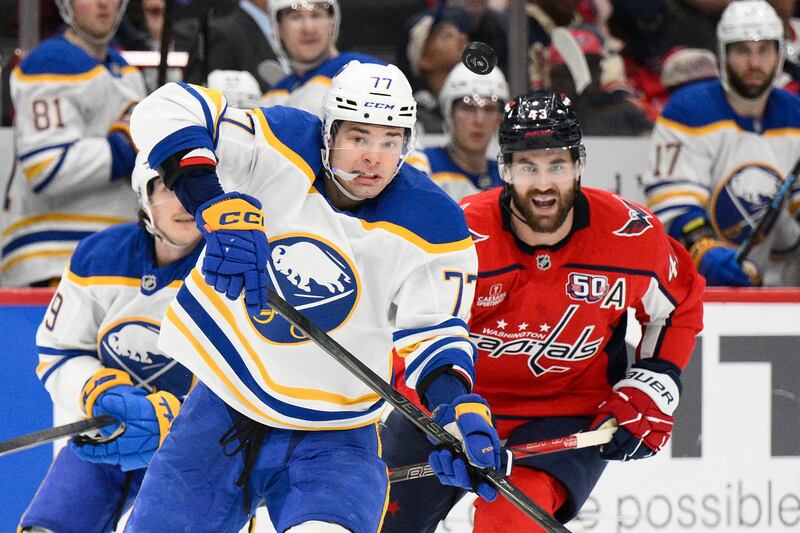JJ Peterka was on a golf trip in Spain with Utah Mammoth prospect Julian Lutz when he found out he’d been traded to Utah.
“We were pretty happy,” Peterka, who hails from Germany, told reporters of the exchange on Friday morning via a Zoom call.
Lutz and Maksymilian Szuber, another German prospect in Utah’s system, are the only Mammoth players Peterka is familiar with. The 23-year-old has spent his entire NHL career in Buffalo, and he’s only played one game at the Delta Center — but the new challenge excites him.
“Playing there once, just the atmosphere was great,” he said. “The fans felt, like, so tight and close to the ice. It’s going to be really exciting.”
“I think he was excited to know that he was going to our team,” said general manager Bill Armstrong the day after the trade. “I think he had done some studying on our club and he was excited about coming here.”
Back-to-back seasons in the 30-goal range with an 18-point increase year over year earned Peterka a five-year contract worth $7.7 million annually immediately upon being traded. He’s drawn significant criticism for his lack of defensive presence, but a deal like that indicates that the organization has faith that it can shape him into a two-way player.
How will Peterka fit in with the Utah Mammoth?
Peterka is best described as a dynamic threat with speed and an elite shot. He’s a new-school NHLer through and through. But he doesn’t feel that he’s hit his peak yet.
“I think there’s still a lot left, and that’s why I have to work hard every day,” he said.
Armstrong agreed.
“If you look at his points last year, he’s roughly around what (Logan) Cooley was last year, so he’s got an opportunity to come in and have an impact on our top two lines,” he said. “I think it’s something that he can grow into. It’s something that he’ll take baby steps in getting here and learning to play our system.”
Off the ice, Peterka described himself as a “super happy person” and a “funny guy” — which is exactly what the team lost when it sent Michael Kesselring and Josh Doan the other way in the trade.
He grew up in Munich — just north of the Alps, the biggest mountain range in Europe. Moving to Utah excites him because it will “feel like home.”
Another thing about Utah that appeals to Peterka is the commitment the organization has shown to building a top-tier team, both on and off the ice. On the ice, he was impressed by the atmosphere at the Delta Center when he played there in March. Off it, he’s excited for the new practice facility in Sandy, which is set to open Sept. 1.
He also mentioned the fit in terms of roster construction. Of the 15 U24 players who scored 60 points or more last season, three of them now play for Utah. And with five first-round picks looking to crack the roster in the next few years, they’re only poised to get better.
Where in the rebuild are the Utah Mammoth now?
Utah missed the playoffs by seven points last season. That’s equivalent to three and a half wins. With the amount of one-goal and overtime losses it suffered, the team was realistically one good scorer away from the postseason.
If Peterka can be that guy, while Cooley and Dylan Guenther take additional steps forward, there’s no reason the team shouldn’t make it next year.
That said, Armstrong is not letting himself get sucked into the belief that Utah is only a piece or two away from the Stanley Cup. That’s why he didn’t pursue any of the big names in free agency, despite the constant reports from national outlets to the contrary.
“A lot of times, you see teams on the front of The Hockey News: They win the summer, but they don’t win in the winter,” he said. “We don’t want to be that team. We want to be built properly for the long run.”
Gathering a core of similar-aged, elite, young players is the name of the game. Peterka fits that perfectly. When those guys (along with a few prospects who project to be NHL-ready in the next few years) achieve their full potential, that’s when Armstrong will take big swings in free agency.


